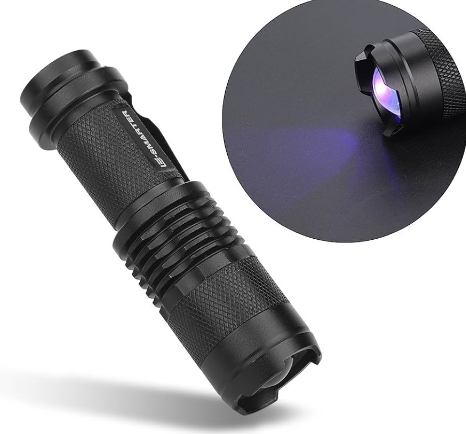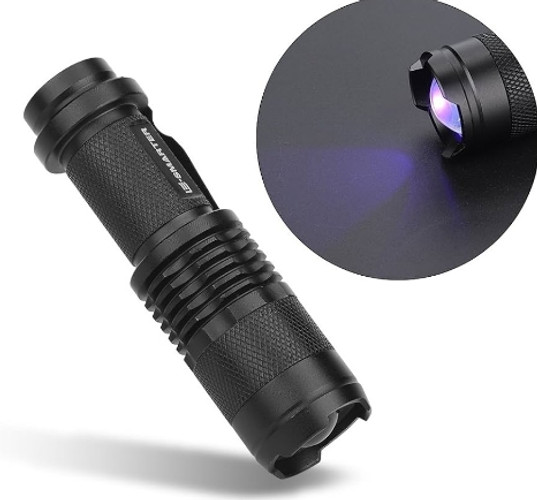Top Trends in UV Flashlight Technology for 2025
Posted by Raymond on 4th Mar 2025
As we move into 2025, the world of UV flashlight technology continues to evolve, offering new capabilities and advancements that cater to a wide variety of industries. Whether you’re using a 365nm UV flashlight for leak detection, forensic investigations, or pest control, the technology powering these devices is getting smarter, more efficient, and increasingly specialized. In this article, we’ll explore the top trends in UV flashlight technology for 2025, highlighting innovations that are shaping the future of UV lighting.
1. Improved LED Efficiency and Power Output
One of the biggest trends in UV flashlight technology for 2025 is the ongoing improvement in LED efficiency. LED lights are becoming brighter while consuming less power, which translates to longer battery life and more efficient performance in 365nm UV flashlights.
| Feature | Before (2024) | After (2025) |
|---|---|---|
| LED Efficiency | Power-hungry, shorter battery life | More efficient, longer runtime on a single charge |
| Brightness | Moderate brightness with limited range | Brighter beams with extended range for outdoor use |
Why It Matters:
Improved LED efficiency means 365nm UV flashlights will be able to perform for longer periods of time without needing frequent recharges or battery changes, which is essential for both professionals and consumers.
2. Smarter UV Flashlight Features: AI and Smart Controls

As artificial intelligence continues to make waves across industries, UV flashlights are starting to integrate AI-driven features. These advanced controls can automatically adjust the intensity of the UV light based on environmental factors such as ambient light or the surface being inspected. This makes 365nm UV flashlights more versatile and user-friendly.
| Feature | Traditional UV Flashlight | AI-Enhanced UV Flashlight (2025) |
|---|---|---|
| Brightness Control | Manual adjustment | Auto-adjusts based on surface and light conditions |
| Battery Monitoring | Basic indicator lights | Intelligent battery management to extend usage |
Why It Matters:
These smart features not only make 365nm UV flashlights more efficient, but also easier to use, especially in complex situations such as forensic analysis or leak detection, where the intensity of the UV light plays a critical role in identifying small details.
3. Multi-Wavelength UV Flashlights
A growing trend for 2025 is the development of multi-wavelength UV flashlights. These devices combine different UV wavelengths (such as 365nm, 395nm, and 405nm) into one flashlight, allowing users to adjust to different situations with the same tool. For example, 395nm UV light is great for detecting counterfeit currency, while 365nm is better for forensic and leak detection.
| Wavelength | Applications |
|---|---|
| 365nm | Forensics, leak detection, art restoration |
| 395nm | Counterfeit detection, pest control |
| 405nm | Scorpion spotting, mineral fluorescence |
Why It Matters:
A multi-wavelength UV flashlight provides more flexibility for professionals who need to switch between applications. This innovation allows users to tailor their tool for a broader range of tasks without carrying multiple devices.
4. Portable and Compact Designs
Portability continues to be a significant design trend in UV flashlight technology. As more people use 365nm UV flashlights for everyday carry (EDC) or outdoor activities, manufacturers are focusing on creating smaller, more compact flashlights without compromising on performance. New designs incorporate lightweight materials and streamlined forms, making them easy to carry and use in any situation.
| Flashlight Design | Before (2024) | After (2025) |
|---|---|---|
| Size | Bulky and less portable | Compact and pocket-sized, easy to carry |
| Material | Standard aluminum or plastic casing | Aerospace-grade materials for durability |
| Features | Basic on/off switch, simple design | Ergonomic design, smart sensors |
Why It Matters:
For consumers using 365nm UV flashlights for EDC, having a compact, lightweight device that fits easily into a bag or pocket is a game-changer. For professionals, portability means they can always have a high-performance UV tool on hand without the bulk.
5. Enhanced Durability: Waterproof and Impact-Resistant
In 2025, durability is a priority for UV flashlight manufacturers. With more users taking their flashlights into rugged outdoor environments, waterproof and impact-resistant designs are becoming standard features. Many flashlights are now built to withstand harsh conditions, including submersion in water and drops from significant heights.
| Feature | Before (2024) | After (2025) |
|---|---|---|
| Waterproof Rating | Basic IPX4 or IPX5 rating | Advanced IPX8 (submersion capability) |
| Impact Resistance | Moderate durability, prone to scratches | Shockproof, drop-resistant, military-grade materials |
Why It Matters:
In industries like forensics or outdoor exploration, a flashlight’s durability can make or break a mission. With advancements in waterproofing and shockproofing, 365nm UV flashlights are now able to perform reliably in extreme conditions, allowing users to take their tools into the field without worrying about damage.
6. Longer Battery Life and Faster Charging
As we move into 2025, battery technology continues to improve. Manufacturers are integrating high-capacity lithium-ion batteries that can last longer on a single charge. Some models now feature fast-charging capabilities, enabling users to recharge their flashlights in as little as 30 minutes.
| Battery Life | Before (2024) | After (2025) |
|---|---|---|
| Standard Runtime | 1-2 hours at full brightness | 4-5 hours at full brightness |
| Charging Time | 2-3 hours to fully charge | 30 minutes for a full charge |
Why It Matters:
A 365nm UV flashlight with extended battery life and fast charging can be invaluable for professionals who rely on their flashlights throughout long shifts, like forensic investigators or field technicians. Less downtime means more productivity.
7. Integration with Augmented Reality (AR) and Mobile Apps
Looking ahead, UV flashlights are starting to integrate with augmented reality (AR) and mobile applications. These integrations can offer users real-time data overlays, advanced analysis features, and even remote diagnostics. For instance, forensic investigators might be able to use an AR-enabled UV flashlight that highlights areas with fluorescent stains and provides instant analysis on their mobile device.
| Feature | Before (2024) | After (2025) |
|---|---|---|
| AR Integration | None | Real-time AR data overlays for enhanced analysis |
| Mobile App | Limited support for battery monitoring | Full mobile control, remote diagnostics, and performance tracking |
Why It Matters:
Integrating 365nm UV flashlights with AR and mobile apps elevates the user experience, making complex tasks such as forensic investigations or scientific research more efficient and data-driven.
Conclusion: The Future of UV Flashlight Technology
In 2025, UV flashlight technology will be smarter, more efficient, and more versatile than ever before. With innovations like AI controls, multi-wavelength flashlights, and advanced durability, the 365nm UV flashlight is set to become an even more indispensable tool across industries ranging from forensics to outdoor exploration.

